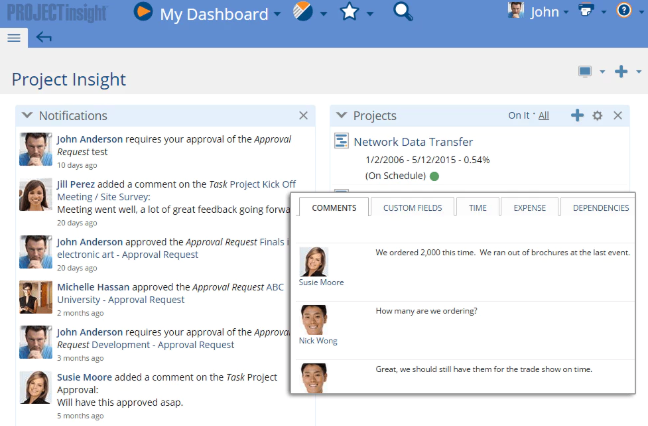How To Get Your Team To Collaborate Using Your PM Tool
We all know the frustration of endless emails and how much information gets lost and fragmented—especially when a project team is trying to use email to collaborate on efforts.
Some people may use “reply all” while others only use “reply.” This leaves part of the group out of the loop, breaks the chain of communication, and can create chaos in the next team meeting when the side conversations get flushed out. Trust can be lost.
Leading research firm Gartner confirms this weakness of emails for project communication and shares other potential issues. Gartner states, “with email, people must triage and organize messages as they come in, resulting in the need to switch contexts between different projects and tasks on a message-by-message basis.” (Full report available to Gartner clients only.)
This is where the collaboration-friendly features of project management software (PM) can alleviate stress and confusion, leading to more successful project deliveries.
 In this article we’ll go over how to jump start collaboration during the rollout of a new project management system, common scenarios of adoption issues, and offer actions you can take to overcome these challenges.
In this article we’ll go over how to jump start collaboration during the rollout of a new project management system, common scenarios of adoption issues, and offer actions you can take to overcome these challenges.
How to jump start collaboration in the new software
It’s important to not spring changes on teams—especially changes that require them to adjust their daily tasks. Send out an announcement of the new tool a week or two in advance, giving everyone a heads up on what to expect and when to expect it. This will warm everyone up to the impending changes.
You should also communicate expectations for the new system formally. Sharing this information formally helps the team feel comfortable going to each other and leaders about concerns and questions.
Many businesses rely on managers to update their direct reports on major changes, thinking this allows for the employee to talk through concerns in the private conversation. But the details shared can vary from convo to convo and the cross-functional teams won’t be receiving the information at the same time.
Depending on your business culture, an email is often the best way to formalize the announcement. Be sure to include:
The name and purpose of the new system
What it’s replacing (if applicable)
Bullet points of what the system is to be used for and what it’s not
Information on the training that will be offered (include the date(s) of the training if known)
The date that everyone will be expected to start using it
Manager and employee one-on-ones should offer time to support the message and walk through the software together—they should not be used as the main source of communication for changes at this level.
Next, let’s walk through some common scenarios you may see in the coming months after the rollout.
Scenario #1: My team says they already collaborate via Skype, email, etc.
More likely than not the team members are using multiple tools to send instant messages and share files with each other. But some or most of this collaboration will not be project-specific. These tools have their place in the way we work today and shouldn’t be discouraged from use, but keeping collaboration for a specific project in the new PM tool will prove extremely valuable.
What to try: Educate the team on how and why the project management tool is the most effective way for them to communicate and collaborate. Be specific. A key purpose of using a PM tool for all project collaboration is that each communication is linked to the project. This is what enables the tool to be the single source of truth for project tasks, deadlines, and handoffs.
Here’s an example of how PM software keeps project communication in one place and tied to the project.


Screenshot of Project Insight’s team collaboration feature (Source)
In regard to instant messaging apps, Gartner says that the private nature of the conversations have limited ability to be retained for future use. It’s important for the team to know that the business values the incredible amount of information and insight exchanged every day between team members—and that this info can be best used when captured and linked to the coinciding project.
Scenario #2: No one has asked questions about the features
When rolling out a new software system, no news isn’t good news. If no one is asking any questions about how to use the system (e.g., how to tag someone in a status update or how to create a new task) it’s likely they haven’t really dived into it.
What to try: In the next team meeting open the system up and make updates during the meeting—sharing your screen so everyone can see. Perform specific functions such as creating a new task and assigning it to a team member. Watching you use the system may spark some questions.
What to try: Send out a short, concise list of what the tool is and is not used for. It’s possible the team isn’t using it because they’re unclear on how the system fits into their current processes and with the other tools they use.
Here are some examples:
What it is | What it’s not |
The source of truth for all project deadlines and due dates. | A replacement of emails for formal approvals or escalations (e.g., change request approval from an executive). |
The best platform to update team members on the specific project. | A one-stop shop for company news and updates. This system is for project-specific updates only. |
The task tracker with the whats, whens, and whos for each project task. | A time-tracking tool used by HR for hourly and/or salaried employees. |
The best way to view the team’s availability, workload, and tasks. | A replacement of the existing process for requesting time off. |
Scenario #3: The team is late to provide their updates in the system
Inform the entire team the deadline for submitting updates. Let them know the reasons behind the deadlines and also how their work is used in other deliverables, such as status reports. This helps build their buy-in for keeping the system up-to-date.
What to try: Give the team a set date and time for which all updates are due and let them know the reason for this deadline. For example, you’ll pull the report 24 hours prior to when the status report is due so you’ll have time to compile all the needed updates. So, if you’re turning in the status report on Fridays at noon, the team needs to have all updates in the system by Thursday at noon.
Not sure what you should be including in your status reports? Check out the checklist we created!
Scenario #4: Only half the team is using it regularly
If you’ve formally shared expectations and held the appropriate training but only part of the team is using the system on a weekly (or daily if applicable) basis, it’s time to ask the team for feedback. You need to hear from the group about why they aren’t using the new tool regularly.
Possible reasons could be confusion of expectations or frustration with the system. Either way, the team will appreciate the opportunity to be heard, and then you can react accordingly. For example, with feedback you’ll be able to schedule training in the tool to work through frustrations and confusion.
What to try: In a team meeting, announce that you’d like feedback on the new system—good and bad. Don’t be afraid to share that there’s been spotty usage and you’re looking to know if they have suggestions for increased adoption. Send out an anonymous survey—Google Forms offers a free one. For this approach to work you must be committed to following up accordingly and acting upon their feedback.
Scenario #5: The communication is lacking enthusiasm
While having communication collected and archived in the PM system is great, you’ll be missing out if the team isn’t engaged in collaboration. The PM tool can be an excellent platform to foster creativity and group problem-solving.
Encourage the team to share ideas for improvement on a specific task or unavoidable workarounds they’ve created. These tidbits can hold goldmines for ways to improve processes and deliverables. Any one of their ideas could result in cost savings or accelerating the timeline.
What to try: Spur the conversation by asking questions in the comment sections. If you follow up on specific suggestions they have and discuss them in team meetings, more people will be inspired to contribute and collaborate.
Many of the issues and the recommendations we discussed are applicable to any new software rollout—not just a project management tool. We hope these suggestions help you address issues that arise in your software rollout.
If you found this article helpful, keep us in mind for the next time your business is looking for new software. Our software experts would love to discuss your needs and help you narrow down the search. They’ll have more useful tips, too!